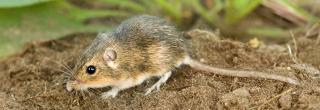
Plains Pocket Mouse
| Scientific Name | Perognathus flavenscens |
|---|---|
| General Description | A medium-sized mouse of 5 inches in length, including tail. Its tail is roughly the same length as its body and has pale black stripe on top. Its fur is a buff gray on top with a lighter underside. A distinct light patch is visible behind each ear. Its hind feet are distinctly larger than its front feet. |
| Status | Year-round resident. |
| Abundance | Rare. |
| Primary Habitat | Found in eastern North Dakota in areas with exposed sand dunes or sandy soils covered with grass. Can also be found feeding in crop fields. |
| Federal Status | No federal status. |
| Reason for Designation | Little is known of the habits and status of this rodent. Only small pockets of this species’ habitat occur within the state. |
Locations and Conditions of Key Habitat
Preferred Habitat
Found in prairie tracts with sand dunes or stabilized sandy soils. Plains pocket mice dig their burrows in loose soils under vegetation. Burrows consist of one tunnel with expanded areas to store seeds. May also be found feeding in grain fields.
Key Areas and Conditions for Plains Pocket Mouse in North Dakota
Plains pocket mice are confined to the southeast part of North Dakota. Part of the Sheyenne National Grasslands in Ransom County contains Plains Pocket Mouse habitat.
Problems Which May Affect this Species
Habitat
Conversion of sandy soil habitat for agricultural use is the greatest threat to this species. Already rare, the loss of remaining sandy soil habitat would be detrimental to the Plains Pocket Mouse.
Other Natural or Manmade Factors
Herbicide and pesticide use on agricultural land may be a threat to this species.
Research and Survey Efforts
Current Research or Surveys
- North Dakota State University is conducting small mammal surveys on the Sheyenne National Grasslands in SE North Dakota.
Previous Research or Surveys
- The University of North Dakota conducted diversity and abundance work of terrestrial vertebrates in tall grass prairies.
- Small mammal inventories have been conducted on Sand Lake NWR, Sheyenne National Grasslands, and Tewaukon NWR.
Additional Research or Surveys Needed
- Information on all aspects of this species’ ecology needs to be examined, including abundance, reproduction, habitat requirements and threats.
- Document remaining sand dune habitat used by this species.
- Develop a monitoring protocol for small mammals.
Management Recommendations
- Work with partners to minimize impacts to grassland habitats.
- Implement restoration projects where possible.
- Consider removal of dilapidated shelterbelts or stands of trees within grassland, particularly within 50 meters of grassland patches >100 ha.
- Implement grazing systems to benefit grassland species.
- Work cooperatively with state and federal agencies to develop BMP’s that promote use of fire.
- Control noxious weeds through biological and chemical methods.
- Use fire or other tools to prevent woody invasion of grassland.
- Work with state and federal agencies to enforce existing pesticide regulations.
- Coordinate with wind energy companies to minimize impacts to grassland habitats.
- Survey areas of data gaps. Conduct research/surveys to establish baseline information on Plains Pocket Mouse.
Monitoring Plans
No monitoring plan for this species has been developed.
2005-2015 Progress
The Plains Pocket Mouse maintains a Level III on the Species of Conservation Priority list. A better understanding of this species historic distribution has been developed, but information on life history is still lacking.

Note: A listing of works consulted when compiling the information on this page may be found in the 2015 State Wildlife Action Plan.
